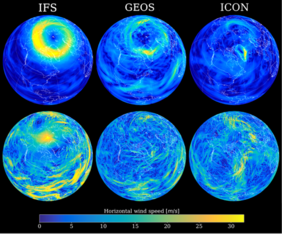Observations show that atmospheric wave energy follows a relatively simple distribution across horizontal scales, from planetary scales down to the scales of small-scale turbulence, a long-standing empirical fact. The reasons for this behavior are poorly understood, and understanding has been hampered by the difficulty to reproduce the observations in models, due to computational limitations on the range of scales models can reproduce. Global storm-resolving simulations, with grid meshes finer than 5 km offer a new opportunity to explore if such spectra robustly emerge in models and if so to understand the processes that determine how wave energy spreads across different scales.
The authors show that all analysed models produce the observed distribution of wave energies at synoptic and sub-synoptic scales, which correspond to horizontal wavelengths of thousands to several hundreds of kilometers. However, the models differ by up to 21% in the total wave energy, as well as in the wave energy distributions at scales smaller than about 500 km.
The study by C. Stephan et al. is the first to use the method of normal-mode function decomposition* for intercomparing kilometre-scale simulations in terms of their simulated waves. This technique allows separating the wave spectrum into two types of waves. One wave type is predominantly associated with slow waves (Rossby waves) and non-divergent horizontal winds, the other with fast waves (inertia-gravity waves) and divergent winds. The models differ by up to 35% in the total energy of inertia-gravity waves and by 24% in the total energy of Rossby waves. The partitioning of the total wave energy between the two types of waves is sensitive to the type of turbulence parameterisation. The energy distributions at scales shorter than 500 km are sensitive to the strength of tropical convection. Models with stronger convective updrafts have more energetic small-scale waves of both types.
Owing to their fine grid mesh, the models of the DYAMOND initiative**, which are subject to the new study, explicitly simulate the effects of many physical processes on the circulation, such as the interaction between the flow and topography, as well as convective clouds, both of which are important sources of waves, which then propagate throughout the entire atmosphere. However, the models are still subject to uncertainty, or differences, in their representation of smaller-scale (sub-kilometer) processes, from turbulent exchanges of energy and momentum, to cloud microphysical processes, to the effects of approximations in their numerical formulation all of which may influence the generation, propagation, and dissipation of waves irrespective of their scale. Quantifying the effects of the different parameterisations on the resolved wind spectra is the goal of a follow-up study.
Original publication:
Stephan, C.C., Duras, J., Harris, L., Klocke, D., Putman, W.M., Taylor, M., Wedi, N.P., Žagar, N., Ziemen, F. (2022) Atmospheric energy spectra in global kilometre-scale models. Tellus A: Dynamic Meteorology and Oceanography. https://a.tellusjournals.se/articles/10.16993/tellusa.26/
More Information:
Website “Cloud-wave coupling”
Personal webpage of Claudia Stephan
*Normal mode function decomposition software package MODES:
https://modes.cen.uni-hamburg.de/
Contact:
Dr. Claudia Stephan
Max Planck Institute for Meteorology
Phone: +49 (0) 40 41173 124
Email: claudia.stephan@mpimet.mpg.de

